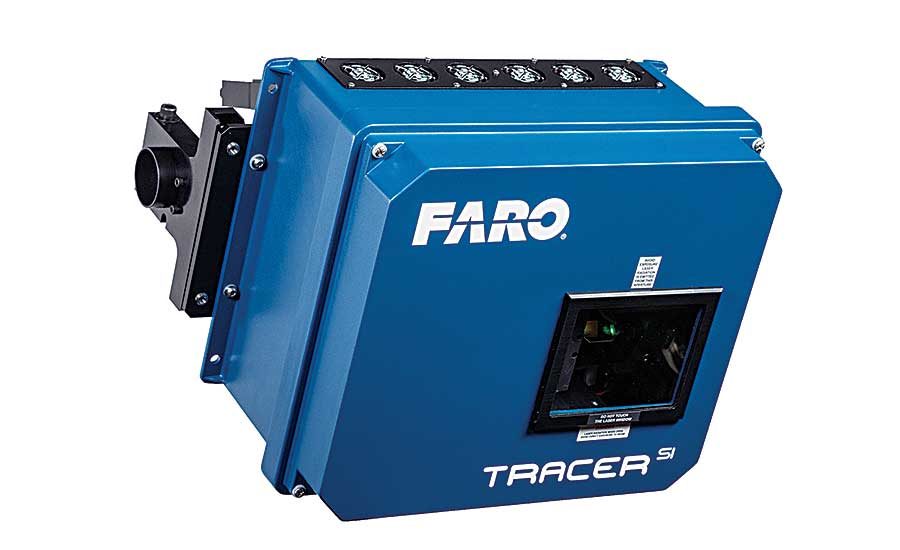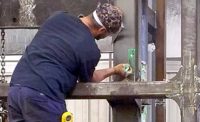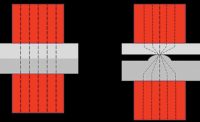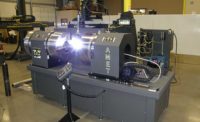For basic welding jobs, companies often rely on blueprints, tools and tape measures to build and weld the parts. However, when using these conventional tools, there’s a high risk of mistakes being made and, at the end, having to break the parts loose, which is expensive and time consuming. It may take two minutes to weld a part to the wrong place, but it can take 10 to 30 minutes to grind the weld and break it loose. Sometimes, even that is not possible. So, instead of rework, the parts must be scrapped, which is even more costly.
Large and complex welding projects present multiple opportunities for errors. Parts might be located in the wrong position or on the wrong side. Symmetrical parts might be welded on backwards because holes are offset. Additionally, when using manual methods and physical templates, full inspections are performed after the assembly process and mistakes become evident only after welding has been completed. With conventional tools, there is no effective way to know if something is welded correctly along the way.
All these elements lead to additional work, additional costs (materials, labor and scrap) and, of course, less productivity. Rework kills forward momentum.
A Better Way
Coupled with BuildIT projector software, the FARO TracerSI laser scanner and projector is an ideal tool to tackle welding projects effectively and efficiently.
The process works like this: The base part to be welded is positioned beneath the TracerSI. The projector then scans the part with a laser to locate it in space. Next, the device accurately projects a laser line onto the object, providing a virtual template that operators and assemblers use to quickly and accurately position components with absolute confidence. After assembly, the projector rescans the assembly to confirm all the parts have been put together accurately. It even detects foreign objects or debris left within the assembly.
Two projector models are available: one with a Class II laser (similar to those in bar code scanners) and another with a Class IIIa laser (similar to those in laser pointers). The laser produces a visible green light with a wavelength of 532 nanometers. Proprietary FARO technology provides superior dynamic accuracy and a rapid refresh rate, which minimizes flicker associated with traditional laser projection systems. The laser is not impaired by dusty work environments, and the projector is sealed against environmental contamination.
Laser templates are created using 3D CAD data, enabling the system to visually project laser outlines of parts, artifacts or areas of interest. The projector software imports native 3D CAD data from all major formats, including CATIA, Siemens NX, SolidWorks, PTC Cree, AutoCAD DXF and DWG. The result is an efficient and accurate method for guided alignment and assembly.
The TracerSI enables accurate and highly repeatable placement of assembly items or weldments from a range of 1.8 to 15.2 meters.
The system offers high-resolution image scanning capability throughout its entire projection volume. As a result, guided welding projects can be set up quickly and easily. The TracerSI is the first device of its kind that fully supports hands-free, feature-based alignment. The system locates reference points on the assembly, such as holes and corners, rather than relying on retroreflective targets that must be applied to the assembly, valued by an external device, and removed after assembly. Targetless setup results in a repeatable alignment process that is easier and faster.
As a result, operators can reliably align parts to holes or corners directly on the base part, with no need for additional cameras, setup or targets. This targetless, feature-based alignment is particularly useful for welding projects involving large and complex assemblies.
The FARO TracerSI laser projections guide operators sequentially, showing where to place every part or component—including the weld bead, which saves additional time and effort. Operators can accurately place the parts to be welded (in the lines), with the proper alignment, so that it becomes easy to weld exactly where the parts need to go on the first try.
Once the part is welded, it’s possible to move to the next part with confidence: the FARO BuildIT projector software will guide the operator through the entire assembly process. The ability to properly sequence welding projects is particularly important because it enables the operator to minimize warpage and distortions that could be a problem in welded assemblies.
Laser projectors are not only useful to ensure proper alignment, they also show the right positioning of specific features, such as holes, in the part to be welded. This way, assemblers can, for example, see the features of a machined part to be sure the holes are shown in the right position, with the right diameter and orientation. This eliminates the risk of assemblers welding on incorrect positions.
Benefits
Using virtual templating and guided assistance technology allows manufacturers to dramatically reduce rework and increase throughput.
First, the TracerSI uses CAD files to provide virtual templating, which eliminates the need for manual tools and physical templates. Manual tools, such as tape measures, can easily generate mistakes. In addition, designing, building, using and maintaining large, heavy templates is expensive and time-consuming. These templates also require a lot of storage space.
Especially with complex welding projects, the TracerSI system saves a significant amount of time. For example, a frame can have up to dozens of “trinket” parts to weld on. Each part requires dedicated steps for manual measurement, alignment and marking (for example, with a chalk line). The TracerSI needs only a few minutes for set up before it can start projecting. In many instances, when conventional tools are used for part placement, the measurement process takes more time than the actual welding.
Overall quality improves due to the laser projector system’s accuracy and repeatability, which dramatically diminish the risk of human error and costly scrap during assembly. Because operators are guided step by step by virtual templates, quality assurance takes place during the welding process and not afterwards, when the welding job has already been completed.
Moreover, the TracerSI enables in-process verification (IPV), which allows manufacturers to detect the presence or absence of features and evaluate placement and alignment. IPV can be performed at various points throughout the welding and assembly sequence. If a part is placed incorrectly, IPV can identify the problem so the welder can take appropriate corrective action before investing more effort in producing what would become a flawed assembly. TracerSI can also detect foreign objects and debris, a necessity in aerospace manufacturing.
An additional advantage of using the TracerSI is that, in cases of engineering changes, companies just need to load the new CAD data into the BuildIT projector software. Days of physical template rework and costs are replaced by less than an hour of time loading the new model into the program. This is particularly advantageous for manufacturers that do a lot of custom or “one off” manufacturing.
Finally, training employees on manual methods—such as reading blueprints, using tape measures, marking chalk lines and using physical templates to position parts for welding—can create ongoing challenges. On the other hand, the TracerSI laser projector is simple to understand and use. The software’s user-friendly interface minimizes both the time and expertise required for operation, eliminating the need for high skilled workers and costly training. TracerSI system allows all operators to lay out and assemble their work packages at the same level and speed. The system takes the guesswork out of the process; operators just follow the sequential projections.
Thanks to all these attributes, manufacturers can have confidence that their welding projects will be completed efficiently and on time.








